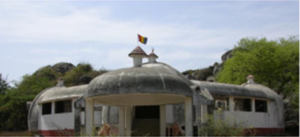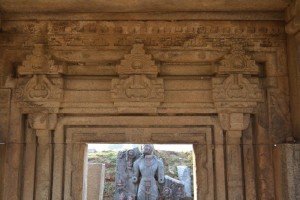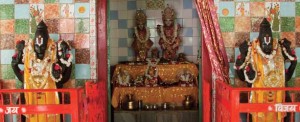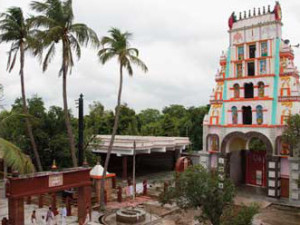 Jahanabad was carved out of old Gaya district on 1st August, 1986. It was a sub-division of the Gaya since 1872. The main aim behind the creation of this district was to accelerate the pace of development in tandem with tackling the problems of extremism, poverty, unemployment and underdevelopment. Jehanabad District has own history from Mughal time. As per book “aine-e-akbari”, place was affected by famine in the 17th century and people were dying of hunger. The Mughal Emperor Aurangzeb, in whose time the book was rewritten, established a Market(Mandi) for relief of the people and named the “Mandi” as “JAHANARA”( Aurangzeb’s Sister). The Mandi was managed under and supervised by Jahanara. She took a good interest in this. After some time the place came to be known as “JAHANABAD” and later as “JEHANABAD”.Its surrounding districts are the district of Patna in north, Gaya in south, Nalanda in east and the newly created district of Arwal in the west.
Jahanabad was carved out of old Gaya district on 1st August, 1986. It was a sub-division of the Gaya since 1872. The main aim behind the creation of this district was to accelerate the pace of development in tandem with tackling the problems of extremism, poverty, unemployment and underdevelopment. Jehanabad District has own history from Mughal time. As per book “aine-e-akbari”, place was affected by famine in the 17th century and people were dying of hunger. The Mughal Emperor Aurangzeb, in whose time the book was rewritten, established a Market(Mandi) for relief of the people and named the “Mandi” as “JAHANARA”( Aurangzeb’s Sister). The Mandi was managed under and supervised by Jahanara. She took a good interest in this. After some time the place came to be known as “JAHANABAD” and later as “JEHANABAD”.Its surrounding districts are the district of Patna in north, Gaya in south, Nalanda in east and the newly created district of Arwal in the west.
How To Reach
By Air (Airport):-
Gaya International Airport is just 55 kms away
By Rail :-
The recently electrified Patna-Gaya branch railway line (P.G. line) traverses through the district and links the Grand Chord with Patna. There are four railway stations- Jehanabad, Court, Tehta and Makhdumpur in the 31 km long stretch of the railways.
By Road :-
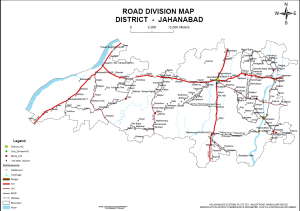 NH-83. NH-110 Jehanabad to Arwal , SH-4,68,69,71 others road-Makhdumpur Hulasganj Rdanj Rd, Kaiji Sari Kako Imaliya road,Babhna Sakurabad Rd,Makhdumpur Barbara Rd,Sarthua Mandil Sakurabad Rd.National Highway No. 83 comes from Patna via Masaurhi, goes directly to Gaya through Makhdumpur and runs almost parallel to the railway line.
NH-83. NH-110 Jehanabad to Arwal , SH-4,68,69,71 others road-Makhdumpur Hulasganj Rdanj Rd, Kaiji Sari Kako Imaliya road,Babhna Sakurabad Rd,Makhdumpur Barbara Rd,Sarthua Mandil Sakurabad Rd.National Highway No. 83 comes from Patna via Masaurhi, goes directly to Gaya through Makhdumpur and runs almost parallel to the railway line.
Popular tourist destinations
JEHANABAD BLOCK
Mahavir Mandir (Babhana):- It is situated 2 km west from Jehanabad town.
Shri Ram Bag (Shahpur ):- It is situated 5 km south-west from Jehanabad town.
Naunia Ghat:– The KP Jayaswal Research Institute, during in the course of its Archaeological Explorations brought to light the site period Medieval. Jehanabad:- The KP Jayaswal Research Institute, during in the course of its Archaeological Explorations brought to light the site period Early medieval. Dhuria:- The KP Jayaswal Research Institute, during in the course of its Archaeological Explorations brought to light the site period Early medieval. Seonari:– The KP Jayaswal Research Institute, during in the course of its Archaeological Explorations brought to light the site period Early medieval. Sidhiya Ghat Pathak Toli:- The KP Jayaswal Research Institute, during in the course of its Archaeological Explorations brought to light the site period Early medieval. Panchmahalla:– The KP Jayaswal Research Institute, during in the course of its Archaeological Explorations brought to light the site period Early medieval. Malahchak:- The KP Jayaswal Research Institute, during in the course of its Archaeological Explorations brought to light the site period Late medieval. Dhangawan:- The KP Jayaswal Research Institute, during in the course of its Archaeological Explorations brought to light the site period Early medieval. Kenari:- The KP Jayaswal Research Institute, during in the course of its Archaeological Explorations brought to light the site period Chalcolithic. Badahar:- The KP Jayaswal Research Institute, during in the course of its Archaeological Explorations brought to light the site period Early medieval. Salarpur:- The KP Jayaswal Research Institute, during in the course of its Archaeological Explorations brought to light the site period Early medieval. Mokar:- The KP Jayaswal Research Institute, during in the course of its Archaeological Explorations brought to light the site period NBPW phase. Surangapur:- The KP Jayaswal Research Institute, during in the course of its Archaeological Explorations brought to light the site period Early medieval. Amaini:- The KP Jayaswal Research Institute, during in the course of its Archaeological Explorations brought to light the site period Early medieval. Lachhmi Bigha:- The KP Jayaswal Research Institute, during in the course of its Archaeological Explorations brought to light the site period Early medieval. Bigha Par:- The KP Jayaswal Research Institute, during in the course of its Archaeological Explorations brought to light the site period Early medieval. Adampur:- The KP Jayaswal Research Institute, during in the course of its Archaeological Explorations brought to light the site period NBPW phase. Daudpur:– The KP Jayaswal Research Institute, during in the course of its Archaeological Explorations brought to light the site period Early medieval. Jamuk:-The KP Jayaswal Research Institute, during in the course of its Archaeological Explorations brought to light the site period Early medieval. Kalpa Kalan:- The KP Jayaswal Research Institute, during in the course of its Archaeological Explorations brought to light the site period Early medieval. Tali Bajar:– The KP Jayaswal Research Institute, during in the course of its Archaeological Explorations brought to light the site period Early medieval. Bhabani Chak:- The KP Jayaswal Research Institute, during in the course of its Archaeological Explorations brought to light the site period Early medieval. Khidirpura:- The KP Jayaswal Research Institute, during in the course of its Archaeological Explorations brought to light the site period Early medieval. Tilangiachak:- The KP Jayaswal Research Institute, during in the course of its Archaeological Explorations brought to light the site period Early medieval.
Korama:-During the course of exploration done by ASI, Buddha and Bodhisattvas, made of black stone belonging to the Early medieval Period were found.
Nev:- During the course of exploration done by ASI, Buddha and Bodhisattvas, made of black stone belonging to the Early medieval Period were found.
Dargah Shah Sailani Baba R.A:-
GHOSI BLOCK
Triloki Bigha:- The KP Jayaswal Research Institute, during in the course of its Archaeological Explorations brought to light the site period Early medieval. Mokan Bigha:- The KP Jayaswal Research Institute, during in the course of its Archaeological Explorations brought to light the site period Late medieval. Girdharpur:- The KP Jayaswal Research Institute, during in the course of its Archaeological Explorations brought to light the site period Early medieval. Nandana:- The KP Jayaswal Research Institute, during in the course of its Archaeological Explorations brought to light the site period Early medieval. Rustampur:- The KP Jayaswal Research Institute, during in the course of its Archaeological Explorations brought to light the site period Early medieval. Chiri:- The KP Jayaswal Research Institute, during in the course of its Archaeological Explorations brought to light the site period Early medieval. Metara:– The KP Jayaswal Research Institute, during in the course of its Archaeological Explorations brought to light the site period Early medieval. Tulsipur:– The KP Jayaswal Research Institute, during in the course of its Archaeological Explorations brought to light the site period Medieval. Sarthua:– The KP Jayaswal Research Institute, during in the course of its Archaeological Explorations brought to light the site period Early medieval. Ismailpur:- The KP Jayaswal Research Institute, during in the course of its Archaeological Explorations brought to light the site period Early medieval. Bharthu:- The KP Jayaswal Research Institute, during in the course of its Archaeological Explorations brought to light the site period Early medieval. Uber:- The KP Jayaswal Research Institute, during in the course of its Archaeological Explorations brought to light the site period Early medieval. Korra:– The KP Jayaswal Research Institute, during in the course of its Archaeological Explorations brought to light the site period Early medieval. Gandhar Math:- The KP Jayaswal Research Institute, during in the course of its Archaeological Explorations brought to light the site period Medieval. Dhonrri (Bazidpur):- The KP Jayaswal Research Institute, during in the course of its Archaeological Explorations brought to light the site period Late medieval. Katauli:- The KP Jayaswal Research Institute, during in the course of its Archaeological Explorations brought to light the site period Early medieval.
MODANGANJ BLOCK
Garh Jalalpur:– The KP Jayaswal Research Institute, during in the course of its Archaeological Explorations brought to light the site period Early medieval. Dhobari:– The KP Jayaswal Research Institute, during in the course of its Archaeological Explorations brought to light the site period Early medieval. Dewara Math:– The KP Jayaswal Research Institute, during in the course of its Archaeological Explorations brought to light the site period Early medieval. Sikandarpur:- The KP Jayaswal Research Institute, during in the course of its Archaeological Explorations brought to light the site period Early medieval. Kurwa:- The KP Jayaswal Research Institute, during in the course of its Archaeological Explorations brought to light the site period Early medieval. Okari:- The KP Jayaswal Research Institute, during in the course of its Archaeological Explorations brought to light the site period Early medieval. Rampur Charui:- The KP Jayaswal Research Institute, during in the course of its Archaeological Explorations brought to light the site period Early medieval.
KAKO BLOCK
Barawan:- The KP Jayaswal Research Institute, during in the course of its Archaeological Explorations brought to light the site period Early medieval.
Lord Shiva Temple (Bhelawar):- It is situated 11 km southeast of Jehanabad railway station in Kako block. It is famous for an old temple of Lord Shiva. The remains of the stone gates of the temple compound can still be seen on the outskirts of the village.(Sculptures of Hindu & Muslim periods) A big fair is organised every year on the occasion of Maha Shivaratri.
According to Jayaswal Research Institute Archaeological Explorations this site belongs to NBPW phase period.
Kosiyawan:– The KP Jayaswal Research Institute, during in the course of its Archaeological Explorations brought to light the site period Early medieval.
Kako:– Kako is equally important both for the Hindus and the Muslims. There is a temple having old statue of Lord Sun in the North-east of Kako village. It is said that Rani Kekai, wife of King Dasharatha and step-mother of Lord Rama had domiciled here for sometime. On her name this village got the name as ‘Kako’. There is also a graveyard of a great  Muslim Sufi Lady-Hazrat Kamalo Bibi, aunt of Hazrat Makhdum Sahib of Bihar Sharif, who is said to have been blessed with divine powers stands as a beacon of social harmony and peace for thousands of devotees belonging to both communities, Muslim and Hindus. This is the dargah of the first woman Sufi saint of the country. Bibi Kamal preached religious tolerance and love in opposition to orthodoxy. For her, there was but one God and the world the reflection of God who permeates everything.People irrespective of their faith visit the Dargah of Bibi Kamal. Bibi Kamal’s Urs takes place in November every year when cooked rice is distributed among devotees seeking her blessings. An inscription of Mahmud Shah Tughluq fixed in the dargah of Bibi kamal, is partly damaged, dated AH 799 (AD 1397), it mentions Khan-i-Mu’azzam A’zam Khan as the governor.
Muslim Sufi Lady-Hazrat Kamalo Bibi, aunt of Hazrat Makhdum Sahib of Bihar Sharif, who is said to have been blessed with divine powers stands as a beacon of social harmony and peace for thousands of devotees belonging to both communities, Muslim and Hindus. This is the dargah of the first woman Sufi saint of the country. Bibi Kamal preached religious tolerance and love in opposition to orthodoxy. For her, there was but one God and the world the reflection of God who permeates everything.People irrespective of their faith visit the Dargah of Bibi Kamal. Bibi Kamal’s Urs takes place in November every year when cooked rice is distributed among devotees seeking her blessings. An inscription of Mahmud Shah Tughluq fixed in the dargah of Bibi kamal, is partly damaged, dated AH 799 (AD 1397), it mentions Khan-i-Mu’azzam A’zam Khan as the governor.
According to Jayaswal Research Institute Archaeological Explorations this site belongs to Early medieval period.
Amthua Masjid (1536):-
Baraki Murari:- The KP Jayaswal Research Institute, during in the course of its Archaeological Explorations brought to light the site period NBPW phase. Usari Garh:- The KP Jayaswal Research Institute, during in the course of its Archaeological Explorations brought to light the site period Shunga-Kushana. Sihati:- The KP Jayaswal Research Institute, during in the course of its Archaeological Explorations brought to light the site period NBPW phase. Dachhni:- The KP Jayaswal Research Institute, during in the course of its Archaeological Explorations brought to light the site period Chalcolithic. Narayanpur:-The KP Jayaswal Research Institute, during in the course of its Archaeological Explorations brought to light the site period Early medieval.
MAKHDUMPUR BLOCK
Tehta :-
Khanqah Ashrafiya Chishtiya Kamriya (Kohra):–
Hazrat Syed Shah Ayub Ashrafi
Mira Bigha:- Mira Bigha village in Jehanabad district is situated at about 4 km. South-East of Tehta Railway Station. This archaeological site is characterized by a cluster of temples, mostly Shaivite, numbering about a dozen. Most of them are brick-worked with some stone appendage. There are ruins of an ancient tank, which may be associated with the site.The site also yielded a host of Brahmanical deities, who once would have resided in these temples . Both, the temples and sculptures, belong to the Pala period of the 9th-10th cent. A.D.
According to Jayaswal Research Institute Archaeological Explorations this site belongs to Early medieval period.
Dharawat:-. It is about 10 Kms north west of Barabar hills, has been identified as the site of the Buddhist monastery of Gunamati. Gunamati, a Buddhist Monk of southern India, defeated Madhava, a Brahman Pandit in controversy.Madhava, on being defeated, vomited blood and died. The king built a great monastery here to celebrate the victory of 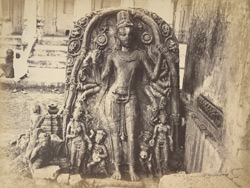 Gunamati. The Chinese pilgrim Hiuen Tsang describe the position of Dharawat.
Gunamati. The Chinese pilgrim Hiuen Tsang describe the position of Dharawat.
A noted scholar and historian FH Hamilton visited Dharawat villages in 1811-12. His travelogue contained descriptions of temples & Buddhist Sculptures.
Photo of Buddhist sculpture from Dharawat was taken by Thomas Fraser Peppé in 1870 this photograph is part of the collection of Sir Richard Carnac Temple.
During the course of exploration done by ASI(74-75), discovered an extensive urn-burial site yielding black and red ware and northern black polished ware in five fabrics at Dharawat.
According to Jayaswal Research Institute Archaeological Explorations this site belongs to NBPW phase period.
Chandrapokhar :- At the foot of the Kunwa hill which shut in Dharawat on the south stretches a large tank known as Chandrapokhar. The name of the tank perpetuates the 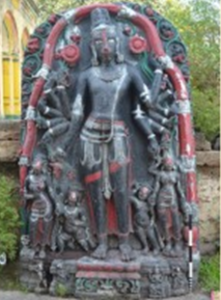 legend that it was excavated by Raja Chandra Sen. Two modern temples at its north eastern corner once contained a large collection of ancient statues including the statue of Kartikayini, the female energy of the war god. The village contains a large number of mound and quite a number of Buddhist statues have been unearthed.
legend that it was excavated by Raja Chandra Sen. Two modern temples at its north eastern corner once contained a large collection of ancient statues including the statue of Kartikayini, the female energy of the war god. The village contains a large number of mound and quite a number of Buddhist statues have been unearthed.
The most remarkable was a colossal image of twelve armed Avalokiteswara Bodhisattva which has now been shifted to the Patna museum.
Supi garh:- The KP Jayaswal Research Institute, during in the course of its Archaeological Explorations brought to light the site period NBPW phase. Suppi Chhaitana:– During the course of exploration done by ASI, Buddha and Bodhisattvas, made of black stone belonging to the Early medieval Period were found. Navgarh:- The KP Jayaswal Research Institute, during in the course of its Archaeological Explorations brought to light the site period Early medieval. Charh:- The KP Jayaswal Research Institute, during in the course of its Archaeological Explorations brought to light the site period Post Gupta. Punahada:- The KP Jayaswal Research Institute, during in the course of its Archaeological Explorations brought to light the site period Early medieval. Newari:- The KP Jayaswal Research Institute, during in the course of its Archaeological Explorations brought to light the site period Early medieval. Ekkil:– The KP Jayaswal Research Institute, during in the course of its Archaeological Explorations brought to light the site period Early medieval. Kalanaur:- The KP Jayaswal Research Institute, during in the course of its Archaeological Explorations brought to light the site period Chalcolithic. Sumera:- During the course of exploration done by ASI, Buddha and Bodhisattvas, made of black stone belonging to the Early medieval Period were found. Berthu:– The KP Jayaswal Research Institute, during in the course of its Archaeological Explorations brought to light the site period Early medieval. Jamanganj:- The KP Jayaswal Research Institute, during in the course of its Archaeological Explorations brought to light the site period Early medieval. Saren:- The KP Jayaswal Research Institute, during in the course of its Archaeological Explorations brought to light the site period NBPW phase. Lalu Ghibara (Tarahua):– The KP Jayaswal Research Institute, during in the course of its Archaeological Explorations brought to light the site period Chalcolithic.
Banabar (Barabar):-
The KP Jayaswal Research Institute, during in the course of its Archaeological Explorations brought to light the site period NBPW phase.
Banavar Dwar :-
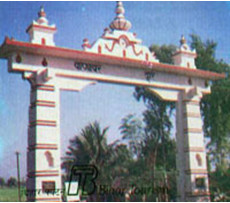 Situated at Mussi more in Makhdumpur on Patna-Gaya International tourist route towards south of Jehanabad at 16th k.m, the gate welcomes the tourist . The design of gate is based on Ancient Buddhist traditions and is a fine blend of modern architect and ancient culture and traditions.
Situated at Mussi more in Makhdumpur on Patna-Gaya International tourist route towards south of Jehanabad at 16th k.m, the gate welcomes the tourist . The design of gate is based on Ancient Buddhist traditions and is a fine blend of modern architect and ancient culture and traditions.
Barabar hills :- It is situated 11 kms to the east of the NH 31 from Makhdumpur on Patna-Gaya Main road and from Mussie more towards east at 10th K.m. It is a Land of Peace & Tranquillity. At the top of the hill where ancient Buddhist and Hindu images are enshrined . Barabar hill is an archaeological showpiece and one of the best tourist spot. The  Historical perspective Barabar or Vanavar, has connections with the Mahabharata period. The great warrior of Mahabharata war, Ashwathama is said to be wandering even today in the valleys of Barabar. He had become immortal with the grace at Lord Sidhnath (Lord Shiva), whose temple(Baba Sidheshwar Nath Temple )exists on the top of the highestmountain of Barabar hills.In ancient times, Barabar was known as “KHALIT PARWAT” or “Nagarjuni parwat”.During Mahabharata (a mythological epic) period, this was known “Gorthagiri” Either because the demon king Vanasur ruled here or because almost all the hills are of same height, this place came to be known as Banavar or Barabar in course of time. The hills have been identified with the Gorathagiri as mentioned in the Mahabharata (a mythological epic) by Jackson who discovered two inscriptions mentioning this name in the hill itself. The other inscriptions in the caves here also refer it as Khalatika and Pravaragiri. Vanasur was the senapati of the king Jarasandh and had constructed a fort on the hills, the remains of which can be seen even today. On the eastern side of Patalganga, Vanasur had also established the new city named “Ram Gaya” on the banks of the Niranjana river known as Falgu now-a-days. The remains of this city have also been found in the forms of bricks and rocks. Fort and Town site are explored by Alexander Cunningham in about 1865.
Historical perspective Barabar or Vanavar, has connections with the Mahabharata period. The great warrior of Mahabharata war, Ashwathama is said to be wandering even today in the valleys of Barabar. He had become immortal with the grace at Lord Sidhnath (Lord Shiva), whose temple(Baba Sidheshwar Nath Temple )exists on the top of the highestmountain of Barabar hills.In ancient times, Barabar was known as “KHALIT PARWAT” or “Nagarjuni parwat”.During Mahabharata (a mythological epic) period, this was known “Gorthagiri” Either because the demon king Vanasur ruled here or because almost all the hills are of same height, this place came to be known as Banavar or Barabar in course of time. The hills have been identified with the Gorathagiri as mentioned in the Mahabharata (a mythological epic) by Jackson who discovered two inscriptions mentioning this name in the hill itself. The other inscriptions in the caves here also refer it as Khalatika and Pravaragiri. Vanasur was the senapati of the king Jarasandh and had constructed a fort on the hills, the remains of which can be seen even today. On the eastern side of Patalganga, Vanasur had also established the new city named “Ram Gaya” on the banks of the Niranjana river known as Falgu now-a-days. The remains of this city have also been found in the forms of bricks and rocks. Fort and Town site are explored by Alexander Cunningham in about 1865.
The Barabar Caves have been selected as one of the 10 sites in Bihar for World Heritage Status.
Best Season for tourist is from The month of November to February. In the month of July-August “Shrawani Mela” is organized. It Starts from the 1st day of Hindi “Saawan Month”, and observed for one month.
It is open for visit between 10 to 5:00pm.
Barbara & Buddhism :- There is an organic relationship between Barabar & Buddhism. Some historians believe that this is the place where Lord Buddha meditated for a long period of 12 Years, and from here only he moved along side “Niranjana river” (Falgu) towards Bodh Gaya where he got enlightenment. If this fact can be established through research and survey of the area this place will be of no less importance than Bodhgaya and Sarnath.Near the second Nagarjuna cave constructed by the Mauryan king Dashratha there are ruins, which according to cunningham was a Buddh-Vihar and was demolished by Muslim attackers and made a platform inste.
Karan Chaupar Cave(Barabar hills):-
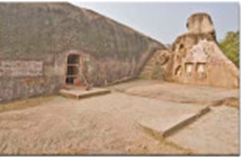 Karan Chaupar Cave facing north is excavated, during the reign of Ashoka, in the hardest granite with infinite care and the interior surface contains high polish and is burnished like glass, consists of a single chamber 33 x 61/2 x 14 feet with a vaulted roof 6 x 1 ½ feet high at the sides and 11 feet high in the centre. Inside the chamber at the western end is a low platform which may have served as a seat for a religious teacher to have used while preaching/ holding discourses with his students or the laity. The entrance is in “Egyptian art form,” i.e. sloping jambs. To its right above is a damaged inscription of 5 lines of the 19th regnal year of Asoka (245 BC.) referring to the name as Supiya cave and of the hill as Khalatika. Outside the cave, to the west, on a fairly large rock are two rudely carved human figures and a linga – all creations of a much later date.
Karan Chaupar Cave facing north is excavated, during the reign of Ashoka, in the hardest granite with infinite care and the interior surface contains high polish and is burnished like glass, consists of a single chamber 33 x 61/2 x 14 feet with a vaulted roof 6 x 1 ½ feet high at the sides and 11 feet high in the centre. Inside the chamber at the western end is a low platform which may have served as a seat for a religious teacher to have used while preaching/ holding discourses with his students or the laity. The entrance is in “Egyptian art form,” i.e. sloping jambs. To its right above is a damaged inscription of 5 lines of the 19th regnal year of Asoka (245 BC.) referring to the name as Supiya cave and of the hill as Khalatika. Outside the cave, to the west, on a fairly large rock are two rudely carved human figures and a linga – all creations of a much later date.
Sudama Cave(Barabar Hill):-
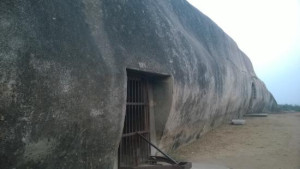 Sudama Cave is located on the southern face of the Barabar Hills has a sunken rock-cut recess 6 ½ feet square and 2 feet deep.The cave consists of two chambers, the inner one being roughly circular in plan, about 19 feet in diameter, and having a hemispherical vaulted roof. The second outer room is 32 ‘ 9″ x 19 ‘6″ with a vaulted roof and with a shallow recess at its eastern end, left rough and unfinished. An inscription on the eastern wall of the entrance recess refers to the building of the cave in the 12th regnal year of Asoka (252 BC.) for the ascetics of Ajivika sect, mentioning the name of the cave as ‘Nigoha-kubha’ or “banyan tree cave. It is earliest examples of rock cut cave Architecture in north India.The cave is remarkable for the highly polished stones and its entrance is designed in Egyptian form. According to the legend, Sudama, a close friend of Lord Krishna had stayed in this cave. Hence it got its name as Sudama Cave. While digging in the front of the cave, pieces of carved pillars were found indicating the possibility of the existence of a built-up pillared porch covering the entrance.
Sudama Cave is located on the southern face of the Barabar Hills has a sunken rock-cut recess 6 ½ feet square and 2 feet deep.The cave consists of two chambers, the inner one being roughly circular in plan, about 19 feet in diameter, and having a hemispherical vaulted roof. The second outer room is 32 ‘ 9″ x 19 ‘6″ with a vaulted roof and with a shallow recess at its eastern end, left rough and unfinished. An inscription on the eastern wall of the entrance recess refers to the building of the cave in the 12th regnal year of Asoka (252 BC.) for the ascetics of Ajivika sect, mentioning the name of the cave as ‘Nigoha-kubha’ or “banyan tree cave. It is earliest examples of rock cut cave Architecture in north India.The cave is remarkable for the highly polished stones and its entrance is designed in Egyptian form. According to the legend, Sudama, a close friend of Lord Krishna had stayed in this cave. Hence it got its name as Sudama Cave. While digging in the front of the cave, pieces of carved pillars were found indicating the possibility of the existence of a built-up pillared porch covering the entrance.
Lomas Rishi Cave(Barabar Hill):-
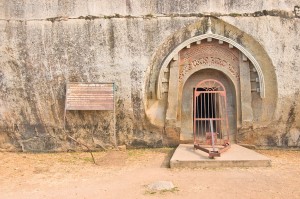 Only a few feet from the Sudama Cave is the Lomas Rishi cave, faces south and consists of two chambers, the outer one being 32’4″ x 19, 4″ and the inner chamber measures roughly 14’3″ x 17′. Only the outer room walls are polished, the rest of the cave having been left rough and unfinished. It is regarded as the first example of the famous Buddhist Chaitya arch style in India. The façade of the cave has fine lattice work carving and the doorway is designed in Egyptian form. In the semi-circular space above the door are two inscriptions of later Gupta period (7th-8th century CE.), both referring to Kings Sarddulavarman and his son Anantavarman of the Maukhari dynasty, the former also stating that in this cave of the Pravaragiri hill the king Anantavarman installed an image of Lord Krishna. In 1914 Jackson discovered another Brahmi inscription about 20 feet high above the level of the lintel which refers to the hill being known as Gorathagiri.
Only a few feet from the Sudama Cave is the Lomas Rishi cave, faces south and consists of two chambers, the outer one being 32’4″ x 19, 4″ and the inner chamber measures roughly 14’3″ x 17′. Only the outer room walls are polished, the rest of the cave having been left rough and unfinished. It is regarded as the first example of the famous Buddhist Chaitya arch style in India. The façade of the cave has fine lattice work carving and the doorway is designed in Egyptian form. In the semi-circular space above the door are two inscriptions of later Gupta period (7th-8th century CE.), both referring to Kings Sarddulavarman and his son Anantavarman of the Maukhari dynasty, the former also stating that in this cave of the Pravaragiri hill the king Anantavarman installed an image of Lord Krishna. In 1914 Jackson discovered another Brahmi inscription about 20 feet high above the level of the lintel which refers to the hill being known as Gorathagiri.
Visva Jhopa Cave or the hut of Viswamitra(Barabar hills):-
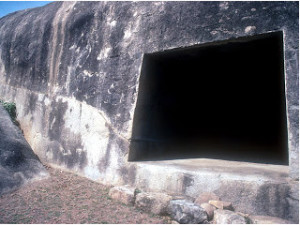 It is reachable by Ashoka steps hewn in cliff. It is one of the cave out of four cave, which were excavated in a large and hardest block of granite to the eastward of the main ridge of the Barabar hills It consists of two room , one inner apartment, which is rough and unpolished, and an anti-chamber which is high polish and are burnished like glass and contains an inscription regarding the reign of Ashoka, for the ascetics of Ajivika sect.
It is reachable by Ashoka steps hewn in cliff. It is one of the cave out of four cave, which were excavated in a large and hardest block of granite to the eastward of the main ridge of the Barabar hills It consists of two room , one inner apartment, which is rough and unpolished, and an anti-chamber which is high polish and are burnished like glass and contains an inscription regarding the reign of Ashoka, for the ascetics of Ajivika sect.
Ashoka Steps :-
The steps were sculpted during Ashoka era for the ascetics to ascend the caves.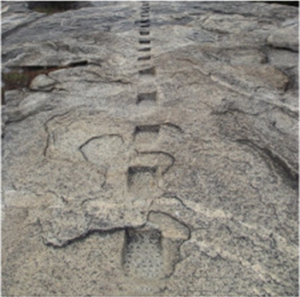
Old Well :-
A The locals believe that water of the well has therapeutic and digestive properties.
Kalpavriksha:-
Prachin Mandir near barabar caves:-
Rock-cut-images :-
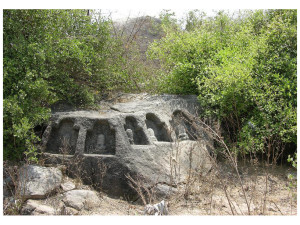
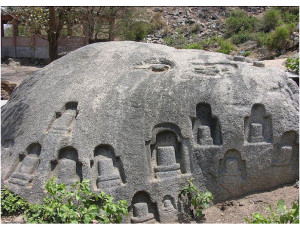 On the rocks in the passage leading to the HOLY SIDHESHWAR NATH TEMPLE are ancient rock cut sculptures or Shivalinga, figures of Ganesh etc. There are a number of seats and rest areas to be encountered on the way.The path passes a number of interesting carvings along the way. Many of these take the form of Lingams, a revered Hindu symbol connected to the god Shiva, who’s temple is to be found at the top of Siddheshwar Peak. Some of these lingams are housed in small shrines and niches carved into the solid rocks, whilst others are carved on the top or sides of sandstone or gneiss boulders.
On the rocks in the passage leading to the HOLY SIDHESHWAR NATH TEMPLE are ancient rock cut sculptures or Shivalinga, figures of Ganesh etc. There are a number of seats and rest areas to be encountered on the way.The path passes a number of interesting carvings along the way. Many of these take the form of Lingams, a revered Hindu symbol connected to the god Shiva, who’s temple is to be found at the top of Siddheshwar Peak. Some of these lingams are housed in small shrines and niches carved into the solid rocks, whilst others are carved on the top or sides of sandstone or gneiss boulders.
Sidheshwar Nath:-
Situated about 11 km from Makhdumpur. It contains a hillock known as Sidheshwar Nath. 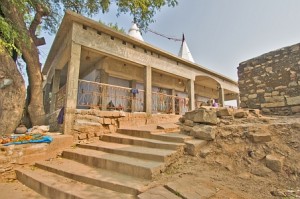
 A modern temple, the Holy Baba Siddhnath temple, is located on one of the highest peaks in the range of the hills, stands on the original basement of an ancient temple. The temple belongs to the Gupta period and is as old as the 7th century A.D. or earlier. The local legends attribute the temple to Bana Raja, the father-in-law of the epic king Jarasandha of Rajgir.
A modern temple, the Holy Baba Siddhnath temple, is located on one of the highest peaks in the range of the hills, stands on the original basement of an ancient temple. The temple belongs to the Gupta period and is as old as the 7th century A.D. or earlier. The local legends attribute the temple to Bana Raja, the father-in-law of the epic king Jarasandha of Rajgir.
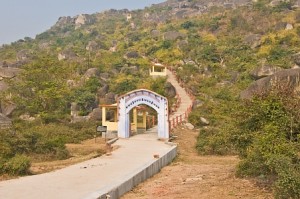 The old and difficult mountainous path to the temple has been renovated with a pucca and safe stairway leading from the base of the hill at Anand Sarovar (Lake).
The old and difficult mountainous path to the temple has been renovated with a pucca and safe stairway leading from the base of the hill at Anand Sarovar (Lake).
Anand Sarovar (Lake) & Nauka Vihar :-
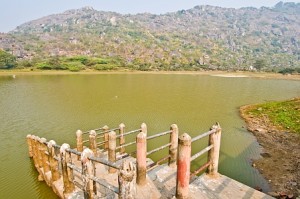
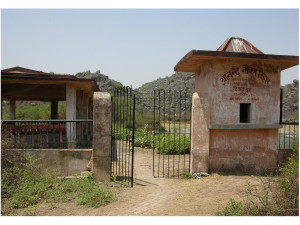 The Anand Sarovar (lake), located as high as 1000 feet above the Patal Ganga, is an ideal location for boating and watersports. Pedal boats are available for boating in the lake.
The Anand Sarovar (lake), located as high as 1000 feet above the Patal Ganga, is an ideal location for boating and watersports. Pedal boats are available for boating in the lake.
Patal Ganga :-
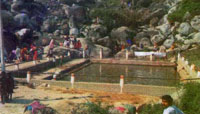 A lake near by Bhaikh is called the Patal Ganga said to have been excavated by Emperor Ashoka.
A lake near by Bhaikh is called the Patal Ganga said to have been excavated by Emperor Ashoka.
Remnants of Ancient Dam:-
Barabar Children’s Park :- Equipped with seesaws, slides, merry-go-round, Swings, the amusement park provides entertainment to the young tourists.
Nagarjuni hill :-
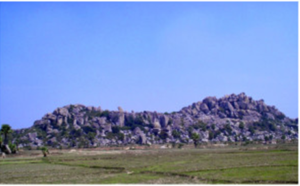 It is about 2 kilometers to the North from Barabar hill is the Nagarjuni hill consisting of two narrow ridges of granite running nearly parallel about a km distance from each other. The southern ridge contains three caves, which has in many ways are quite similar to the Barabar Caves.It drive their name from Nagarjuna, a famous Buddhist teacher who lived in one of these caves.These caves were built for the Buddhist monks during Ashoka and Dashrath (Ashoka’s grandson) during 3rd cent BC. Monks of the now extinct Ajivika sect too were believed to have resided and practiced their religion in these caves.
It is about 2 kilometers to the North from Barabar hill is the Nagarjuni hill consisting of two narrow ridges of granite running nearly parallel about a km distance from each other. The southern ridge contains three caves, which has in many ways are quite similar to the Barabar Caves.It drive their name from Nagarjuna, a famous Buddhist teacher who lived in one of these caves.These caves were built for the Buddhist monks during Ashoka and Dashrath (Ashoka’s grandson) during 3rd cent BC. Monks of the now extinct Ajivika sect too were believed to have resided and practiced their religion in these caves.
Gopi or Gopika cave (Gopi-ka-Kuba):- The Nagarjuni Hills southern ridge contains three excavated caves the largest of which is 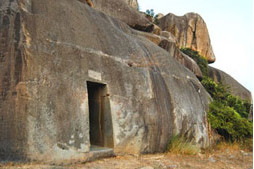 known as the Gopi Cave. On the outside immediately over the doorway of an Idgah, a small sunken tablet contains an inscriptions stating that this Gopi’s Cave was devoted by Dasaratha (321 B.C), the grandson of Asoka.
known as the Gopi Cave. On the outside immediately over the doorway of an Idgah, a small sunken tablet contains an inscriptions stating that this Gopi’s Cave was devoted by Dasaratha (321 B.C), the grandson of Asoka.
Vadathika Cave(Vadithi-ka-Kuba):-
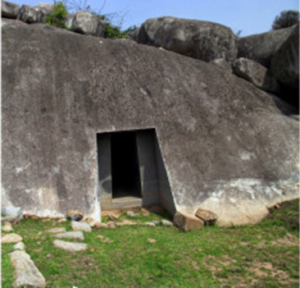 It is westward to Gopi’s Cave and is entered by a narrow passage about 3 ft in width. In an inscription on the right- hand jamb of the doorway this cave is called the Vadathika.
It is westward to Gopi’s Cave and is entered by a narrow passage about 3 ft in width. In an inscription on the right- hand jamb of the doorway this cave is called the Vadathika.
Vapiyaka Cave or Mirza Mandi (Vapiya-ka-Kuba):-
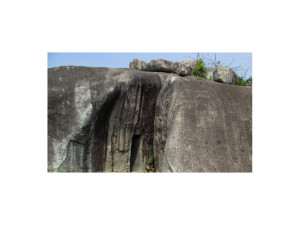 Next to Vadathika Cave, has a small porch or anti-chamber, from which a narrow doorway leads to the principal room. The inscription on the left hand side of the porch shows that the cave was called Vapika.The Nagarjuni caves were excavated in the 1st year of the reign of Asoka’s grandson Dasaratha about the year 321 B.C., dedicated to the Ajivikas.
Next to Vadathika Cave, has a small porch or anti-chamber, from which a narrow doorway leads to the principal room. The inscription on the left hand side of the porch shows that the cave was called Vapika.The Nagarjuni caves were excavated in the 1st year of the reign of Asoka’s grandson Dasaratha about the year 321 B.C., dedicated to the Ajivikas.
Old Museum building :-
Kavua Dol :- It is situated 6 km south-west of the Barabar hills. It if detached hill of about 500 ft high. The name literally means ‘crow’s swing’ watch, it is said, is derived from the 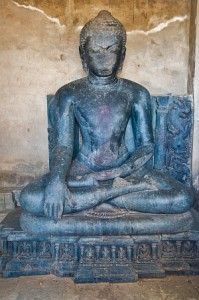
 fact that a huge block of stone was once lying so well balanced on the existing pinnacle of the hill that it used to rock even when a crow alighted on it.This place is the site of ancient monastery of Silabhadra who was a learned Buddhist of the royal family of Samatata. The remains of monastery is still exist. The ruins of an ancient Buddhist temple at the eastern foot of the hill consisting the colossal statues of Buddha in the sitting posture and is in fair preservation.The figure is about 8 ft height.
fact that a huge block of stone was once lying so well balanced on the existing pinnacle of the hill that it used to rock even when a crow alighted on it.This place is the site of ancient monastery of Silabhadra who was a learned Buddhist of the royal family of Samatata. The remains of monastery is still exist. The ruins of an ancient Buddhist temple at the eastern foot of the hill consisting the colossal statues of Buddha in the sitting posture and is in fair preservation.The figure is about 8 ft height.
Thirteen sandstone pillars, that once supported an open hall in front of this temple still stand.
There are numerous figure caved in high relief on the rock (Rock cut sculpture).

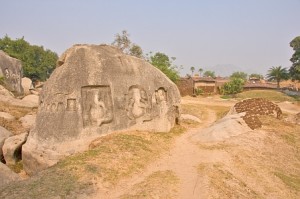 Most of the figures are Brahmanical these are are carved on the southern and eastern faces of some rocks and boulders, on the face of an isolated round boulder separated by a distance of 12 feet from the south-eastern corner, on the northern -eastern faces of some rocks and of four Hindu deities one on each side of an oblong isolated boulder to the east of the Kauwadol Hill
Most of the figures are Brahmanical these are are carved on the southern and eastern faces of some rocks and boulders, on the face of an isolated round boulder separated by a distance of 12 feet from the south-eastern corner, on the northern -eastern faces of some rocks and of four Hindu deities one on each side of an oblong isolated boulder to the east of the Kauwadol Hill
Sagarpur:- The KP Jayaswal Research Institute, during in the course of its Archaeological Explorations brought to light the site period Medieval.
Kachanawan:- During the course of exploration done by ASI, it is noticed as an ancient site, yielded black- and northern black polished wares, silver and copper punch-marked coins and copper cast coins. Buddha and Bodhisattva’s, made of black stone belonging to the Early medieval Period were found. Two sculptures one of dancing Ganesha and other of Simhavahini Durga were also obtained. According to Jayaswal Research Institute Archaeological Explorations this site belongs to Early medieval.
Makarpur:- The KP Jayaswal Research Institute, during in the course of its Archaeological Explorations brought to light the site period Early medieval. Sabadalpur:- The KP Jayaswal Research Institute, during in the course of its Archaeological Explorations brought to light the site period Late medieval. Madanpur:- The KP Jayaswal Research Institute, during in the course of its Archaeological Explorations brought to light the site period Early medieval.
Bhanebigha:- During the course of exploration done by ASI, Buddha and Bodhisattvas, made of black stone belonging to the Early medieval Period were found.
Dharanai:– During the course of exploration done by ASI, Buddha and Bodhisattvas, made of black stone belonging to the Early medieval Period were found.
Umata:- During the course of exploration done by ASI, Buddha and Bodhisattvas, made of black stone belonging to the Early medieval Period were found.
Bhelavar:- During the course of exploration done by ASI, it is noticed as an ancient site, yielded black- and northern black polished wares, silver and copper punch-marked coins and copper cast coins.
RATNI FARIDPUR BLOCK
Pandaul:– The KP Jayaswal Research Institute, during in the course of its Archaeological Explorations brought to light the site period Medieval. Mahua Bigha:- The KP Jayaswal Research Institute, during in the course of its Archaeological Explorations brought to light the site period Early medieval. Chagori:- The KP Jayaswal Research Institute, during in the course of its Archaeological Explorations brought to light the site period Meidevlal. Kurahari:- The KP Jayaswal Research Institute, during in the course of its Archaeological Explorations brought to light the site period Early medieval. Sikandarpur:- The KP Jayaswal Research Institute, during in the course of its Archaeological Explorations brought to light the site period Early medieval. Kansua:- The KP Jayaswal Research Institute, during in the course of its Archaeological Explorations brought to light the site period NBPW phase. Ratni:- The KP Jayaswal Research Institute, during in the course of its Archaeological Explorations brought to light the site period Medieval. Ramse Bigha:- The KP Jayaswal Research Institute, during in the course of its Archaeological Explorations brought to light the site period Early medieval. Pokhawan:- The KP Jayaswal Research Institute, during in the course of its Archaeological Explorations brought to light the site period Late medieval Kankot Bigha:- The KP Jayaswal Research Institute, during in the course of its Archaeological Explorations brought to light the site period Early medieval. Sendhwa:- The KP Jayaswal Research Institute, during in the course of its Archaeological Explorations brought to light the site period Early medieval. Rasulpur:- The KP Jayaswal Research Institute, during in the course of its Archaeological Explorations brought to light the site period Early medieval. Saura chak (Chicksaura):- The KP Jayaswal Research Institute, during in the course of its Archaeological Explorations brought to light the site period Early medieval. Baijnathganj:- The KP Jayaswal Research Institute, during in the course of its Archaeological Explorations brought to light the site period Early medieval. Uttarapatti:- The KP Jayaswal Research Institute, during in the course of its Archaeological Explorations brought to light the site period NBPW phase.
Uttara:- During the course of exploration done by ASI, it is noticed as an ancient site, yielded black- and northern black polished wares, silver and copper punch-marked coins and copper cast coins.
Mohammadpur:- The KP Jayaswal Research Institute, during in the course of its Archaeological Explorations brought to light the site period Early medieval. Mustichak:- The KP Jayaswal Research Institute, during in the course of its Archaeological Explorations brought to light the site period Early medieval. Pirijpura:– The KP Jayaswal Research Institute, during in the course of its Archaeological Explorations brought to light the site period Early medieval. Gananpura:- The KP Jayaswal Research Institute, during in the course of its Archaeological Explorations brought to light the site period Early medieval. Jahangirpur:- The KP Jayaswal Research Institute, during in the course of its Archaeological Explorations brought to light the site period Early medieval. Kindue Kothi (Uttari Tola):- The KP Jayaswal Research Institute, during in the course of its Archaeological Explorations brought to light the site period Early medieval. Saidi Chak:-The KP Jayaswal Research Institute, during in the course of its Archaeological Explorations brought to light the site period Early medieval. Hasanpura:- The KP Jayaswal Research Institute, during in the course of its Archaeological Explorations brought to light the site period Early medieval. Lalu Bigha:- The KP Jayaswal Research Institute, during in the course of its Archaeological Explorations brought to light the site period Early medieval. Dharampur:- The KP Jayaswal Research Institute, during in the course of its Archaeological Explorations brought to light the site period Early medieval. Ghenjan:- The KP Jayaswal Research Institute, during in the course of its Archaeological Explorations brought to light the site period Early medieval. Salempur:- The KP Jayaswal Research Institute, during in the course of its Archaeological Explorations brought to light the site period Early medieval. Saraiya Bazar:- The KP Jayaswal Research Institute, during in the course of its Archaeological Explorations brought to light the site period Early medieval. Malahchak:-The KP Jayaswal Research Institute, during in the course of its Archaeological Explorations brought to light the site period Early medieval. Gaya Bigha:- The KP Jayaswal Research Institute, during in the course of its Archaeological Explorations brought to light the site period Early medieval. Galimapur:– The KP Jayaswal Research Institute, during in the course of its Archaeological Explorations brought to light the site period Early medieval. Brahmthan:- The KP Jayaswal Research Institute, during in the course of its Archaeological Explorations brought to light the site period Early medieval. Ambedkar Nagar:- The KP Jayaswal Research Institute, during in the course of its Archaeological Explorations brought to light the site period Early medieval. Shri Bigha:- The KP Jayaswal Research Institute, during in the course of its Archaeological Explorations brought to light the site period Early medieval. Talipar:- The KP Jayaswal Research Institute, during in the course of its Archaeological Explorations brought to light the site period Early medieval. Shivganj-Mukari:- The KP Jayaswal Research Institute, during in the course of its Archaeological Explorations brought to light the site period Early medieval. Nim Bigha:- The KP Jayaswal Research Institute, during in the course of its Archaeological Explorations brought to light the site period Early medieval. Bhuia Toli:- The KP Jayaswal Research Institute, during in the course of its Archaeological Explorations brought to light the site period Early medieval.
HULASGANJ BLOCK
Lat:- It is situated in the village Lath 3 km from Umata. It is an ancient monolithic granite pillar 53.25 ft long and 3 ft in diameter lies in the open field in Plot No.1047 .This 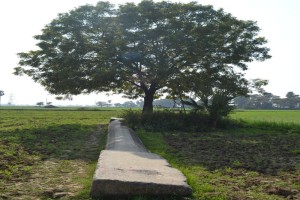 immense column lying horizontally on the ground pointing north and south.
immense column lying horizontally on the ground pointing north and south.
According to Jayaswal Research Institute Archaeological Explorations this site belongs to Later Gupta period.
Bhagwanpur:- The KP Jayaswal Research Institute, during in the course of its Archaeological Explorations brought to light the site period Early medieval. Sukiyawan:-The KP Jayaswal Research Institute, during in the course of its Archaeological Explorations brought to light the site period Early medieval. Dumri:- The KP Jayaswal Research Institute, during in the course of its Archaeological Explorations brought to light the site period Late medieval. Surajpur:- The KP Jayaswal Research Institute, during in the course of its Archaeological Explorations brought to light the site period Early medieval.
Dabthu:- It is 6 Kms east of Hulasganj in Jehanabad, Dabthu. It is chiefly known for its finely carved images and ruins of temples of post Gupta Period. A noted scholar and historian FH Hamilton visited Dabthu and adjoining villages in 1811-12. His travelogue contained descriptions of
dilapidated structures of magnificent temples including a jain temple, a mausoleum of a sufi saint and numerous images of Hindu gods and goddesses around the temples. Buchanan also talks of a sprawling earthen mound which is still extant. Now little remains of those shrines and idols as described by hamilton and Buchanan. However, in the remains of ancient shrines one can still see images of deities mutilated and decayed by ravages of time.
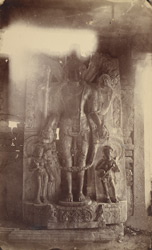 This photograph of a Surya sculpture was taken by Thomas Fraser Peppé in 1870 and is part of the collection of Sir Richard Carnac Temple. Descriptive notes by Peppé accompanying the photographs read as follows, ‘This seems to have been the site of a large Buddhist community, and the remains are extensive. There are two temples partly standing. The northern one was dedicated to Surya, and a large figure of the same is still standing inside’.
This photograph of a Surya sculpture was taken by Thomas Fraser Peppé in 1870 and is part of the collection of Sir Richard Carnac Temple. Descriptive notes by Peppé accompanying the photographs read as follows, ‘This seems to have been the site of a large Buddhist community, and the remains are extensive. There are two temples partly standing. The northern one was dedicated to Surya, and a large figure of the same is still standing inside’.
According to Jayaswal Research Institute Archaeological Explorations this site belongs to Early medieval period.
Murgawan:–nThe KP Jayaswal Research Institute, during in the course of its Archaeological Explorations brought to light the site period NBPW phase. Tesaur:- The KP Jayaswal Research Institute, during in the course of its Archaeological Explorations brought to light the site period NBPW phase. Sarwan:- The KP Jayaswal Research Institute, during in the course of its Archaeological Explorations brought to light the site period Early medieval. Walipur:–The KP Jayaswal Research Institute, during in the course of its Archaeological Explorations brought to light the site period Early medieval. Chiri:- The KP Jayaswal Research Institute, during in the course of its Archaeological Explorations brought to light the site period Early medieval. Lodipur:- The KP Jayaswal Research Institute, during in the course of its Archaeological Explorations brought to light the site period Early medieval. Dhongra:– The KP Jayaswal Research Institute, during in the course of its Archaeological Explorations brought to light the site period Early medieval. Hulasganj:- The KP Jayaswal Research Institute, during in the course of its Archaeological Explorations brought to light the site period Early medieval.
Sri Lakshmi Narayan Temple:- It is established in 1969 AD by Swami Rang Ramanujachary. The building also houses a Sanskrit high school lending it a gurukul kind of ambience, .The sanctum has marble statues of Goddess Lakshmi and Narayana besides two small statues of Laddu- Gopal.
Outside the sanctum, two 5 feet statues of Jai and Vijaya are kept, which are called sevaka (servants) of God, besides two statues of Ramanujacharya and Swami Parankushacharya while to the east, statues of Lord Garuda and Hanuman are kept on a cemented platform.
Pran Bigha:- The KP Jayaswal Research Institute, during in the course of its Archaeological Explorations brought to light the site period Medieval. Rustampur:- The KP Jayaswal Research Institute, during in the course of its Archaeological Explorations brought to light the site period Early medieval. Kokarsa:- The KP Jayaswal Research Institute, during in the course of its Archaeological Explorations brought to light the site period Early medieval. Miyapur:- The KP Jayaswal Research Institute, during in the course of its Archaeological Explorations brought to light the site period Early medieval. Jaru:- The KP Jayaswal Research Institute, during in the course of its Archaeological Explorations brought to light the site period Early medieval.
Keur:-During the course of exploration done by ASI, it is noticed as an ancient site, yielded black- and northern black polished wares, neolithic celts, microliths, represented by  geometric and non-geometric tools, made on chert, carnelian and quartz, silver and copper punch-marked coins and copper cast coins.
geometric and non-geometric tools, made on chert, carnelian and quartz, silver and copper punch-marked coins and copper cast coins.
According to Jayaswal Research Institute Archaeological Explorations this site belongs to Early medieval period.
Girai:- The KP Jayaswal Research Institute, during in the course of its Archaeological Explorations brought to light the site period Early medieval. Raghunathpur:– The KP Jayaswal Research Institute, during in the course of its Archaeological Explorations brought to light the site period Early medieval. Katauli:- The KP Jayaswal Research Institute, during in the course of its Archaeological Explorations brought to light the site period Medieval.


